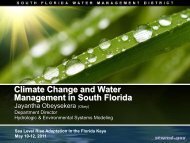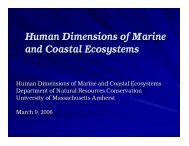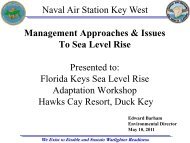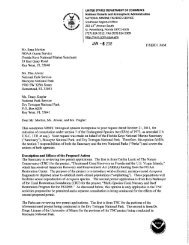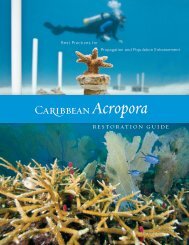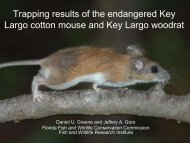Caribbean Acropora Restoration Guide - The Florida Reef ...
Caribbean Acropora Restoration Guide - The Florida Reef ...
Caribbean Acropora Restoration Guide - The Florida Reef ...
Create successful ePaper yourself
Turn your PDF publications into a flip-book with our unique Google optimized e-Paper software.
Chapter 3 | Coral Gardening Methodology<br />
Coral Collections<br />
Goal: Minimize impact to donor colonies and maximize survivorship of fragments and nursery corals.<br />
Site Selection<br />
Once a suitable site for the coral nursery has been selected and materials have been deployed, corals will need to<br />
be collected to serve as nursery stock. <strong>The</strong> first step in coral collections is to choose collection sites. <strong>The</strong>re are<br />
several factors to consider when choosing these sites.<br />
• Existing Wild Populations: As in nursery selection, knowledge of natural healthy populations of<br />
<strong>Acropora</strong> coral within a reasonable proximity to the selected nursery site will be critical in guiding<br />
collection efforts. <strong>The</strong> overall size and health of potential donor colonies are important and affect<br />
both the health of subsequent fragments collected from the donor and the potential impacts to the<br />
donor. Minimizing impacts and pressure on colonies present at any particular site is an important part<br />
of the goal stated at the beginning of this section.<br />
• Size of the Area: <strong>The</strong> geographic area from which wild donor colonies are harvested should be large<br />
enough to ensure genetic diversity between collected corals while minimizing transport time between<br />
the collection site and the nursery.<br />
• Proximity to Nursery Site: If monitoring of wild donor colonies is required, close proximity to the<br />
nursery site may be an important logistical and financial consideration. Also, minimizing transport<br />
times helps to reduce stress and likelihood of damage to newly collected fragments.<br />
• Number of Sites: Collecting from a variety of areas or habitats may further increase the likelihood of<br />
genetic variation within the nursery as well as the ability of nursery-reared corals to adapt to different<br />
habitats and environmental conditions.<br />
• Permitting: Local permitting and marine zoning in certain areas may also guide the selection of<br />
collection sites.<br />
Methodology<br />
• Tools: Small branch clippings from wild donor colonies can be collected using a variety of cutting<br />
tools, including stainless steel surgical bonecutters,<br />
diagonal electrical wire cutters, needlenose pliers,<br />
etc. For colonies with thicker branches, PVC<br />
cutters have also proven effective. Taking care to<br />
cut the branch cleanly and evenly ensures optimal<br />
survival of the fragment as well as rapid healing and<br />
recovery of the donor colony. See Figure 3.<br />
Photo: Ken Nedimyer<br />
• Transport: Widely varied methods have been tested<br />
and used for transporting coral fragments, and the<br />
selection of one particular method should depend on<br />
the conditions at each nursery site. Fragments taken<br />
from donor colonies should be transported to the<br />
nursery site as quickly as possible to minimize stress<br />
and placed in the shade to maintain temperature and<br />
Figure 3: Collecting fragments of A. cervicornis<br />
17





